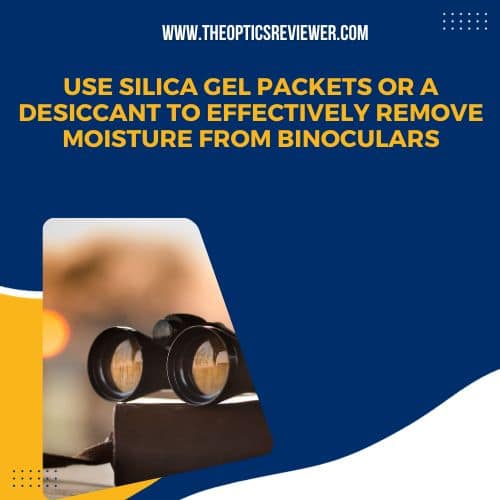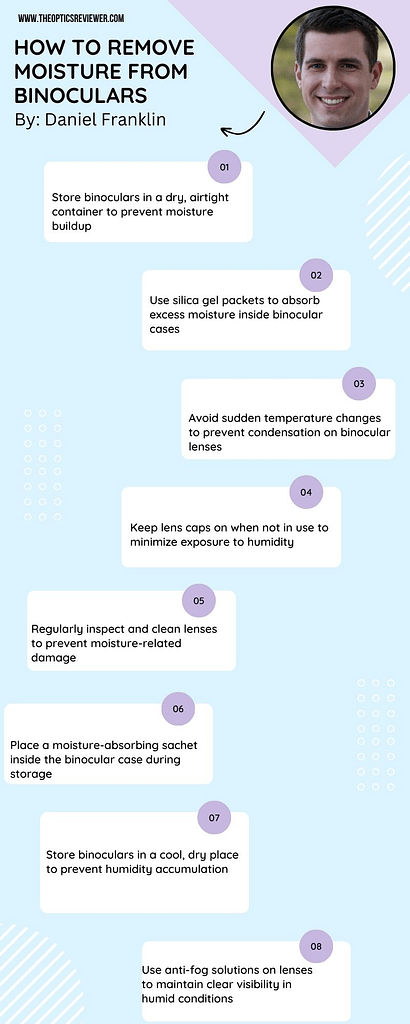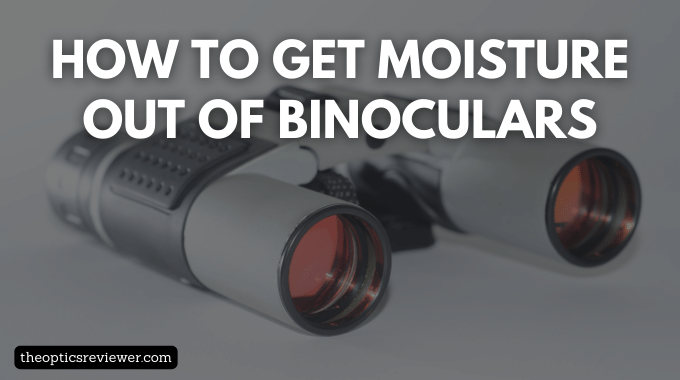We all have binoculars at home that we use for our various indoor and outdoor pursuits. But, if you want to get the best from them, you should know how to get moisture out of binoculars. There are certain things that you should know about. But before we begin, here is some information about binoculars.
Binoculars help us keep up with what’s happening in our worlds and help us see the world as it actually is. We can use binoculars to help us see the stars in more detail than we can on our own, adjusting the focus and ensuring that what we’re seeing is as clear as possible. These are generally easier to do with a tripod, which lets you use a steady hand while you hold your eye fixed on the target of your viewfinder.
They can also help us read the fine details of a landscape or something as insignificant as a tiny decoration. Binoculars are often used to share a look at minor details and scenes which we pass by without noticing and are also helpful for spotting animals, shapes, and objects in the air because it’s hard to see them in the blink of an eye.
Contents
- 1 Key Highlights
- 2 What Causes Moisture Build-Up in Your Binoculars?
- 3 How to Get Moisture out of Binoculars?
- 4 How to Take Care Of Your Binoculars?
- 5 Conclusion
- 6 References
- 7 FAQs
- 7.1 Are Fog-Proof Binoculars Worth it?
- 7.2 How To Prevent Water From Getting Into Your Binoculars?
- 7.3 How to Get Moisture Out Of Your Canon Binoculars?
- 7.4 How Do You Clean The Inside Of Your Binoculars?
- 7.5 How Do You Fix Cloudy Binoculars?
- 7.6 How Do You Remove Mold From Binoculars?
- 7.7 How Do You Lubricate Binoculars?
Key Highlights
- Place binoculars in an airtight container with desiccant packs to absorb moisture and prevent condensation.
- Store binoculars with silica gel packets or place them in a bag with uncooked rice to absorb excess moisture.
- Use a gentle heat source, like a hairdryer on low, to remove moisture, but avoid excessive heat to prevent damage.
- Clean lenses with a microfiber cloth or lens cleaning solution to eliminate any remaining moisture spots.
What Causes Moisture Build-Up in Your Binoculars?
Storage in a humid and hot environment and condensation from breathing onto the lens during continuous usage are all possible sources of moisture built-up in binoculars. Moreover, moisture may build up on lenses and other components within binoculars in humid and high-temperature environments. On the other hand, the user’s breath may condense on the binoculars’ lenses in cold temperatures and can result in moisture build-up.
Now, the question arises, “Do you really need to get moisture out of the binoculars?” Yes! Of Course, you need to get rid of that moisture as it can cause issues like fogging of your lenses, reducing light transmission, thus, reducing the overall optical quality. Furthermore, in the worst-case scenario, it can result in mold or fungus growth in the binoculars’ assembly and rusting, all of which can cause severe damage to your binoculars.
So now, once you know the causes of moisture build-up and whether or not you should remove it, let’s move to the main question, how to get moisture out of binoculars.

How to Get Moisture out of Binoculars?
You might not know the best way to get moisture out of binoculars as a beginner. You might think it’s just about letting them dry on their own, and you are not wrong to try it first. Simply storing the affected binoculars in a warm, dry location, possibly close to a heat source, and waiting a few days is the easiest Course of action. You can check to see if the binoculars are completely dry after a few days, but if that is not the case, then we have to move towards more effective techniques.
So, when you get water into binoculars, the optics are probably already soaked, and if you don’t address this issue timely, it can cost you a lot in the long run. Now, there are many ways to get the moisture out of the binoculars, and we will discuss them thoroughly here so that you won’t miss out on even a teeny-tiny detail.

1. Using a Desiccant
One of the solutions that can work is using a desiccant like uncooked rice or silica gel to dry up the interior of the binoculars. What these desiccants do is that they absorb all the moisture that got its way into your binoculars. So you have to take a desiccant of your choice, like uncooked rice, in a zip-lock bag and afterward submerge your binoculars in it. Seal the bag and let it be for about 24 hours. Mostly, you will get the desired results in 24 hours, but in case of severe moisture problems, it can take longer.
2. Using a Soft Cloth
You can use the cloth that is included in your binocular package for cleaning purposes. But it’s not the only way to do it, as you can use a microfiber towel to get the moisture out of your binoculars.
You can also use a microfiber towel or other soft material to wrap binoculars for golf. Before storing the binoculars, please keep them in a warm, dry area to dry off. It is worth mentioning that binoculars should be kept out of the direct sun at all costs.
3. Buying a Pair of Fog-proof Binoculars
Let us discuss the most practical method, and that is to buy a pair of waterproof and fog-proof binoculars. Such binoculars can save you from all the trouble of cleaning your binoculars because, honestly speaking, we all know that the cleaning method is not as easy as it sounds and can be tricky sometimes.
You can buy a pair of binoculars that are waterproof and fog proof, O-ring sealed, and purged with some inert gas like nitrogen or argon. It is worth mentioning that argon gas has larger molecules as compared to nitrogen gas, so it has better retention power. Hence, there are more chances of nitrogen leaking out after a shock or impact than argon, making the unit susceptible to water damage. However, argon purging is more expensive than nitrogen purging.
By purging binoculars with an inert gas like nitrogen or argon, you may avoid internal fogging, provide a waterproof environment, and avoid mold and fungus growth. Thus, binoculars marketed as “fog-proof” are filled with inert gas to replace any naturally occurring oxygen and prevent moisture build-up, which otherwise can cause the binoculars to fog up and even foster mold growth or mildew.
It is worth mentioning that not only the “waterproof” and “fog-proof” binoculars are purged with inert gas, but after purging to further prevent any moisture build-up, the binoculars are sealed (O-ring sealed). The nitrogen or argon-purged binoculars are made waterproof during the sealing process, preventing moisture from gathering around the lenses, thus halting mold and fungus growth.
If interested you can read more about auto focus binoculars.
4. Binoculars With Mold or Fungus Growth
Once we have discussed some common tips and tricks to get the moisture out of the binoculars, let us address the elephant in the room and discuss what to do in case you spot a mold or fungus growing in its assembly. Well, Yeah! That is quite a big issue that can negatively impact the quality of the binoculars.
So if you have left your binoculars in a humid environment for too long and without any care or precaution, then mold or fungus growth on your binoculars lens is inevitable.
When fungus or mold first appears in your binoculars, it may already be advanced to the point where it has dispersed spores into the minuscule crevices of the entire inner assembly. Since this will require disassembling the binoculars, we advise you to seek professional assistance.
As we have discussed in detail how to get moisture out of binoculars, let’s take a quick sneak peek at how to take care of your binoculars.
How to Take Care Of Your Binoculars?
Sportspeople, birdwatchers, and hunters widely use binoculars. They are expensive and usually need to be cleaned every few months. If you are an avid sportsman or a spy, you might have a binocular sitting in your drawer for years, or maybe you use it every day but have no idea how to clean it. So, if you want to save yourself from all the hustle of how to get moisture out of spy binoculars, here are a few tips to keep your binoculars clean and good as new in the first place.
If interested you can read about binoculars for people with glasses.
- Don’t drop your binoculars. These are delicate items; if dropped, they can be damaged and break or even cause severe damage to the optics. Always put them down before you leave a room, especially when bringing children into the house, to avoid injuring them accidentally by dropping things on them.
- Clean your binoculars regularly. Cleaning the binoculars at least once a week is recommended to help keep them clean and in working order. You can use some cleaning solvent, spray them off and then wipe them down with a damp cloth. But whatever you do, don’t leave anything stuck to the glass or the lenses when you’re done. This will result in scratching and other damage to the optics.
- Use a thin, fine bristles brush to remove tiny particles from your binoculars without harming the lenses.
- The best way to remove fingerprints is with a soft-bristle brush similar to what you use for cleaning your makeup brushes. For fingerprints on the lenses, wipe them off with a soft-bristle cloth soaked in a cleaning solution. Use this to clean the lenses.
- As for stains–don’t use anything that is not labeled “Cleaning Solution.” The chemical qualities of these products make them ideal for cleaning other things, but they will not work on binoculars as efficiently on lenses. The chemicals are poisonous and may cause you to harm the binoculars if used on them. Some products designed to clean your binoculars are safe and effective, but they require a little more effort than others since they do not work in your binocular case or on the lenses themselves. These cleaners contain alkaline substances that remove oil and dirt from your optics without harming them.
- When cleaning your binoculars, ensure you do not use abrasive products like sandpaper, as these can scratch the lenses and cause them to deteriorate quickly.
- Replace spare lenses as soon as they start to appear damaged or browned or when the glass starts to become sticky and a bit smudgy with new ones bought from your local optical supplier (unless you buy them in bulk).
- Clean the structure of the lenses with a dry, soft cloth. Using a rag is not recommended at all.
- Take the binoculars off the tripod and clean them with a dry cloth, so they don’t become sticky or oily.
- You can use a soft, clean, dampened cloth to wipe the lenses of your binoculars, turning them around and over each other to eliminate any dirt and dust build-up on the lenses and between them. This helps keep the lenses clean and free of dirt and dust.
- Binocular lenses are made of glass, have a high degree of optical quality, and will not be damaged by cleaning. If you don’t clean your binoculars, they may get scratched or damage the eyepiece when you focus or zoom in on an object. A lens cleaner is also a good idea to save time cleaning your binocular lenses. Binoculars can be cleaned with soap and water or your lens cleaner. If you are concerned about your lenses’ safety, check that they are coated to prevent scratching.
- Cleaning the lenses is a two-step process. First, remove the protective black cloth that comes with your binoculars, then use a soft, white, dampened cloth to wipe them clean from front to back and side to side. This should get rid of any dirt that’s accumulated on the inside of the lenses. Once done, put the protective cloth back on and spin the binoculars until they are clean and shiny. This is a two-step process and takes about 2 minutes to do. If you find that your binoculars do not come with a cleaning cloth, you can use any old cotton or linen cloth to clean them. Ideally, however, you should use a soft cloth free of starch and powder or similar chemicals. This way, they will last longer and be as shiny as new.
- After cleaning the binoculars, slide the protective cloth back onto them. You can keep them this way for about a week before reusing them. Remember to put them away in a safe place.
- It’s always better to get your binoculars out of harm’s way while on the tripod. Don’t drop or shake them around too much.
- Be sure not to touch the lens of any old binoculars or cameras with your fingers, as this could damage them.
- When you need to take these binoculars out of the case, use a thin cloth or paper between the eyepiece lens and your fingers. This will help protect them from dust and dirt.
- Don’t leave any old binoculars in your car’s glove compartment, as dust accumulates, especially with older leather models.
- A high humidity, high temperature, or dusty environment is not a good place to store binoculars. Binoculars should ideally be stored in a plastic bag or an airtight container with desiccant like silica gel packets.
- Lastly, it will be best if you are prepared for the possibility of moisture intrusion with non-waterproof binoculars. It is advisable to carry such binoculars in a waterproof bag or not to spend an extended period outdoors in the rain.
Conclusion
We hope you have understood the key points of how to get moisture out of binoculars. Binoculars can prove to be an excellent comrade of yours, and the best way to extend their lifespan is to keep them squeaky clean and dust-free, but you should never use abrasive materials or harsh chemicals to do so.
To prevent inner condensation of the binoculars, ensure they are absolutely dry. Moreover, at all costs, you should avoid subjecting them to a humid environment and high temperatures like over 90 degrees Fahrenheit or 32 degrees Celsius, as this may potentially harm their quality.
To cut a long story short, we have thoroughly discussed how to get moisture out of binoculars and take care of them, but if the moisture built up is really high or there is mold in your binoculars, it is always better to seek professional help.
Have a nice day!
References
- https://bpspsychub.onlinelibrary.wiley.com/doi/abs/10.1111/j.2044-8295.1965.tb00939.x
- https://www.spiedigitallibrary.org/conference-proceedings-of-spie/0098/0000/Binocular-Summation-And-Its-Implications-In-The-Collimation-Of-Binocular/10.1117/12.955287.short
- https://coopereyecare.com/wp-content/uploads/sites/9/2021/08/Intermittent-Exotropia-of-the-Divergence-Excess-Type-Basic-and-Divergence-Excess-Type.pdf
- https://link.springer.com/article/10.1007/BF00235723
FAQs
Are Fog-Proof Binoculars Worth it?
“Binoculars marketed as ‘fog-proof’ use inert gases like nitrogen or argon to replace oxygen, preventing internal fogging, mold, or mildew. The sealed, O-ring process further waterproofs the binoculars, inhibiting moisture accumulation and ensuring lasting clarity in various conditions.”
How To Prevent Water From Getting Into Your Binoculars?
Various anti-fog solutions, including sprays, lotions, wipes, and drops, are available on the market to cover the lenses and stop them from fogging up due to moisture. Moreover, cleaning your lenses frequently will prevent fog from accumulating because of moisture.
How to Get Moisture Out Of Your Canon Binoculars?
You can use a few little silica gel packets as a desiccant and put the binoculars in a sealed bag. Silica gel will absorb all the moisture, which is the best and safest method to get the moisture out of your binoculars. It is worth mentioning that if there is a lot of water built-up in your binoculars, it is better to seek professional help.
How Do You Clean The Inside Of Your Binoculars?
You can use a lens cleaning pen’s bristles to remove light debris while holding the binoculars upside down. Afterward, use canned air to gently blow off the debris but avoid getting too close to the lens, or else they could become frosty.
How Do You Fix Cloudy Binoculars?
To fix cloudy binoculars, first, clean the lenses using a lens cleaning solution and microfiber cloth. If the issue persists, check for internal moisture by placing the binoculars in a sealed bag with desiccant packets for a few days. If the problem persists, professional servicing may be required.
How Do You Remove Mold From Binoculars?
To remove mold from binoculars, wipe the affected areas with a damp cloth and mild soap. For stubborn mold, a mixture of equal parts water and isopropyl alcohol can be applied using a soft brush or cloth, followed by thorough drying.
How Do You Lubricate Binoculars?
To lubricate binoculars, apply a small amount of silicone-based lubricant to the hinge and focus wheel. Ensure not to over-apply, as excess lubrication may attract dust and debris.

